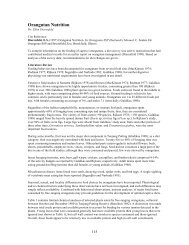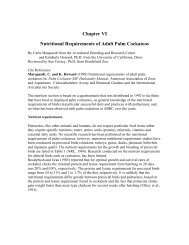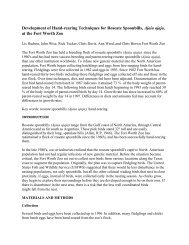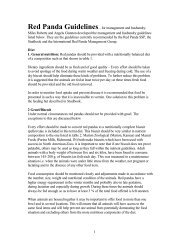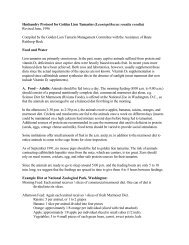AZA - Gibbons Fact Sheet
AZA - Gibbons Fact Sheet
AZA - Gibbons Fact Sheet
You also want an ePaper? Increase the reach of your titles
YUMPU automatically turns print PDFs into web optimized ePapers that Google loves.
elate to differences in habitat and food availability. Otherwise, gibbon<br />
show a similar preference for fleshy, sugary fruit and figs.<br />
Social Organization: <strong>Gibbons</strong> are unique among apes, and even among<br />
Old World monkeys, in keeping strictly defended stable territories which<br />
they live within at all times. <strong>Gibbons</strong> also come close to the ideal of<br />
"mating for life." Each gibbon pair regularly advertises its territory by loud<br />
singing accompanied by spectacular gymnastics--a show of force. The<br />
female's great call dominates the half-hour morning bout of singing, and it<br />
is punctuated by the male's shorter phrases. These songs are consistent<br />
throughout the range for each species, but subtle differences characterize<br />
individuals. Territorial singing of the family broadcasts precise information<br />
on the species and sex of individuals, the area occupied by the parents<br />
and the presence of a sub-adult ready to form a new pair.<br />
Conservation Status: The IUCN Red List of Threatened Animals curently<br />
lists the Javan gibbon (H. moloch) and the Mentawai Islands gibbon (H.<br />
klossii) as endangered; the white-cheeked gibbon, the hoolock gibbon (H.<br />
hoolock) and the pileated gibbon (H. pileatus) are listed as vulnerable. The<br />
U.S. Fish & Wildlife Service lists all nine gibbon species as endangered<br />
and they are also under Appendix I protection of CITES. Most recently, the<br />
IUCN/CBSG Primate Working Group recognized 23 (possibly 26) subspecies<br />
among the nine species, placing the pileated, the Javan, the<br />
Mentawai Islands and all five white-cheeked subspecies as critical.<br />
Threats to Survival: Reduction of the tropical rainforest is the primary<br />
threat to gibbons. Poaching for food or capturing young gibbons for the pet<br />
trade is a secondary, but sometimes equally serious threat. The numbers<br />
of all gibbons in Asia have decreased rapidly in the past fifteen years.<br />
Zoo Programs - SSP: The <strong>Gibbons</strong> SSP is still under going planning and<br />
organization. At the inaugural meeting in 1990 the propagation group<br />
recommended the following plan based upon IUCN Priority Status and<br />
IUCN/Primate Specialist Group and IUCN/CBSG recommendations. a.)<br />
Because of their threatened or endangered status, the Javan, hoolock and<br />
Mentawi Islands gibbon species should be placed in captive breeding<br />
programs meeting necessary criteria, when sufficient numbers of<br />
individuals of each become available. (Possibly in North America or other<br />
regional programs.) b.) The agile (H. agilis) and the gray gibbon (H.<br />
muelleri) have a low priority for conservation and are not to be placed in a<br />
captive breeding program at this time. c.) Because the white-cheeked<br />
gibbon is endangered and a reasonable number of individuals are already<br />
held in North American facilities, expansion of its numbers through<br />
breeding has been recommended. d.) The pileated gibbon should be<br />
placed in a global breeding program, since it is endangered but only low<br />
numbers are held in North America. e.) The siamang and white-handed



